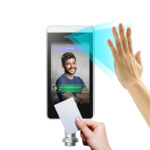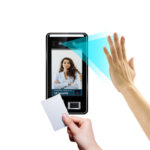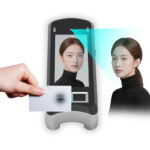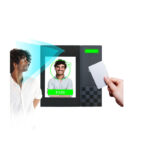Why Masks Challenge Facial Recognition?
Facial recognition systems rely on distinct facial landmarks such as the nose, mouth, and jawline. Masks cover these crucial areas, reducing the points of reference that algorithms use for identification. Studies have shown that older or conventional systems can see a significant drop in accuracy when processing masked faces, which poses challenges for secure access control and identity verification.
How Modern Systems Adapt to Masked Faces
To overcome the challenges posed by mask-wearing, modern facial recognition technologies have evolved significantly:
1.Upper Face Analysis:
Advanced recognition systems increasingly focus on the upper facial region—including eyes, eyebrows, and forehead contours—since these areas remain visible even when masks cover the lower face. Algorithms analyze subtle features such as eye shape, eyelid folds, eyebrow curvature, and skin texture patterns. By emphasizing these stable features, systems maintain a high identification accuracy even when the nose and mouth are obscured.
2.Deep Learning Models
Modern AI models are trained using extensive datasets containing both masked and unmasked faces across different demographics, lighting conditions, and angles. Convolutional Neural Networks (CNNs) and Transformer-based architectures learn to extract invariant facial features from partial images. This enables the system to generalize well and recognize individuals even under diverse masking scenarios, reducing false negatives and improving overall reliability.
3.Multimodal Biometric Authentication
To further enhance recognition accuracy, many systems now integrate multiple biometric modalities. Combining facial recognition with complementary technologies—such as iris scanning, palm vein recognition, or fingerprint scanning—creates a multi-layered authentication process. This multimodal approach compensates for occluded facial features and increases security by requiring verification from independent biometric sources.
4.Mask Detection Features
Some modern systems include dedicated mask detection algorithms that first determine whether a face is partially covered. Once a mask is detected, the system dynamically adjusts its recognition protocols, prioritizing features from the uncovered areas and applying specialized models trained for masked faces. This ensures a seamless identification process while maintaining high accuracy and minimizing false rejections.
Benefits of Mask-Compatible Facial Recognition
1.Enhanced Security
Mask-compatible facial recognition systems maintain accurate identification even when the lower half of the face is covered. By focusing on upper facial features and leveraging AI trained on masked datasets, these systems reduce the risk of unauthorized access while maintaining a high level of recognition accuracy.
2.Seamless Access Control
These advanced systems enable smooth and frictionless entry in workplaces, airports, healthcare facilities, and other public spaces without requiring users to remove masks. Real-time recognition ensures efficient throughput while maintaining strict access protocols.
3.Health and Safety Compliance
By eliminating the need for mask removal during authentication, mask-compatible facial recognition supports public health guidelines and hygiene standards. This reduces potential exposure to airborne pathogens while maintaining secure identification.
4.Versatility and Multimodal Integration
Modern systems can be combined with other biometric modalities such as iris scanning, palm vein recognition, or fingerprint authentication. This layered security approach enhances accuracy and provides robust verification even in complex or high-security environments.
Future Outlook for Masked Face Recognition
As AI and biometric technology advance, mask-compatible facial recognition is becoming a standard feature. Future systems will combine faster processing, higher accuracy, and multimodal biometrics to provide secure, efficient, and hygienic access solutions for public and private sectors.
Заключение
Masks pose a real challenge for traditional facial recognition, but modern AI-powered systems, deep learning models, and multimodal authentication make it possible to see through masks with high accuracy. Products like HFSECURITY’s FR07, RA08, and FP08 showcase how technology adapts to ensure security, convenience, and safety.
Related products
Часто задаваемые вопросы
No, only modern systems designed with mask detection or upper-face analysis can reliably recognize masked faces.
Accuracy depends on system quality, lighting conditions, and whether multimodal authentication is used. High-end systems can achieve recognition rates above 95%.
It can, but combining it with iris scanning, palm vein recognition, or fingerprint scanning provides higher security and reliability.
Yes, many products like HFSecurity FR05 and RA08 are designed for offices, airports, and public areas, providing secure and hygienic access control.
Связаться с нами
We would love to speak with you.
Feel free to reach out using the below details.





